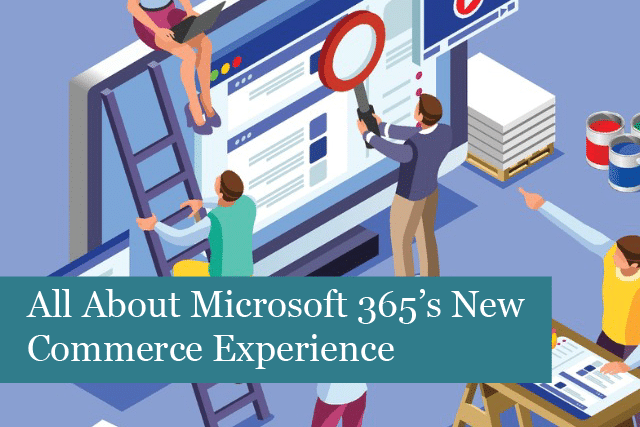
Microsoft 365 recently announced its New Commerce Experience (NCE) , price increases, and new licensing models, all of which took effect on 1st July 2022. We understand this news has caused some concern and confusion. So, we’ve put together an article with what you need to know about these NCE and other changes.
How Will Current Microsoft 365 Products Be Affected?
We stay up to date with all changes made at Microsoft to keep you and our clients updated on changes or price increases on their products.
Here are the current changes summed up right now:
There are coming price increases for certain Microsoft products, such as Office 365 and Microsoft 365 options; these price increases are separate from the New Commerce Experience that’s been announced.
There will be a new licensing model called New Commerce Experience (NCD), which affects Office 365, Microsoft 365, Dynamics 365, Windows 365, and Power Platform subscriptions. It will be possible to purchase monthly licenses or a fixed-term agreement paid upfront monthly or annually.
Which Microsoft 365 Products Are Included Under the Price Increase?
Along with the NCE announcement, Microsoft also announced a price increase for about 20% of all commercial products, with an effective date of 1st July 2022.
Here are some of the updated prices for the company’s most common products (this is not an exhaustive list!) that are subject to the 20% price increase:
- Microsoft 365 Business Basic: was £50 and will go up to £5.40
- Microsoft 365 Business Standard: was £9.40 and will go up to £11.28
- Microsoft 365 Business Premium: was £16.60 and will go up to £19.92
These increases are set to apply globally, with local market adjustments for some regions. However, no price changes are expected for charities, education, and government products right now.
Is There a Way to Avoid Microsoft’s Price Increase?
Yes, there’s one way you may be able to avoid this price increase. Microsoft is offering customers the chance to go to monthly billing with an annual commitment term for all packages.
While this may help you avoid the 20% increase, the new annual commitment fixes the number of licenses for the year, too. That means you can only increase the number of licenses. You’re not allowed to decrease the number of licenses during the contracted term.
In addition, a new annual term license bought after the price increase date starts with a new annual agreement.
What Do I Need to Do Next?
If you’re happy to stay with your monthly plan, with the flexibility to increase and decrease the number of licenses as needed, then you don’t have to take any action. Your new pricing will come into effect on 1st July 2022.
If you would like to stay with your existing price and move to an annual agreement, then contact your IT provider before 1st June 2022 to discuss all available options.
What is NCE?
The New Commerce Experience (NCE) is a “per seat” model for Microsoft 365, Dynamics 365, Windows 365, and Power Platform subscriptions. This model was launched for Microsoft Azure in 2019 and was meant to be a method to simply license purchasing. The NCE looks for customers to have longer contractual terms, though monthly terms will still be available.
With a monthly subscription, NCE offers the ability to purchase Microsoft 365 licenses monthly without an annual commitment. Microsoft sees this as a way to offer more flexibility to customers who need to make monthly changes to their Microsoft 365 or Office 365 licenses and seat count.
The 12-month subscription gives you an opportunity to commit to a specific number of licenses for up to 12 months. However, you can choose to be billed on a monthly or annual basis.
The 12-month subscription locks in pricing for the entire team, and you save money on future price increases. The subscription allows you to increase but not decrease the seat count.
Microsoft will also offer a 36-month subscription underneath their NCE, which makes it possible to secure the same price for three years. This subscription option also includes the option to pay monthly, annually, or upfront. And it allows you to increase but not decrease the seat count.
The goal of Microsoft was to provide more flexibility than legacy plans. However, the old 12-month subscriptions allowed customers to drop seats at any time.
What Do Customers Get with the New NCE Subscriptions?
The 12- and 36-month plans work pretty much alike. Businesses that choose these plans are able to lock their prices in for the term of their subscription, both for current and additional seats. The pricing stays the same as it was under the legacy 12-month plan, and you can still pay by the month.
The biggest change is that it’s no longer possible to make seat reductions at any point. Now, these can only be done at the end of the 12- or 36-month plan terms. Businesses that have high seasonal workforce expansion and contraction rates will find this change not ideal for their situations.
The monthly plans offer everything the other plans include, with a lower period of commitment. You can add and reduce seats at the end of every month, which offers more flexibility. However, the flexibility and the lack of commitment will be priced 20% more than the other plans.
Summing It Up
While many companies will feel the sting of the price increases and lack of seating changes during their term, there are still some benefits to Microsoft’s NCE. For one thing, many businesses may find it easier to adopt new products and add-ons. That’s because these services will no longer require separate billing and payment systems.
In addition, Windows 365 will not be available on a monthly basis (with annual pricing). What’s more, the NCE is independent of already-announced price increases.
So, if you find all of this confusing, it’s a good idea to get in touch with your IT service provider. They can walk you through the changes and how your company may be affected. Your IT service provider can also recommend the best options for your business under the new NCE terms and prices.
Recommended Posts

IT Simplified: What Is A Firewall?
21st March 2025

10 cyber security tips
14th March 2025

